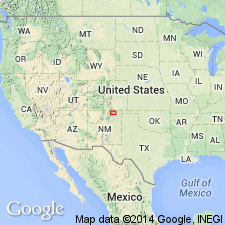
- Usage in publication:
-
- Potato Canyon coal bed*
- Modifications:
-
- First used
- Dominant lithology:
-
- Coal
- AAPG geologic province:
-
- Las Vegas-Raton basin
Summary:
First use of name; intent to name not stated, and no type locality designated. Probably named for Potato Canyon, west of Raton, Colfax Co, NM in Las Vegas-Raton basin. Underlies an area of several sq mi along and north of the Canadian River, and it extends south into the head of Crow Creek and Coal Canyons, in eastern part of Raton coal field. Is a coal bed in Raton Formation, located in the upper, coal-bearing division of three field divisions of Raton Formation. Raton Formation is overlain by Paleocene Poison Canyon Formation, and overlies Late Cretaceous Vermejo Formation--Vermejo conformably overlies Trinidad Sandstone but is locally absent beneath the base of overlying Raton Formation. Potato Canyon coal bed lies about 950-1,050 ft above the Trinidad Sandstone. Is as much as 8.45 ft thick in Potato Canyon, but individual beds within the zone rarely reach 3 ft in thickness. Characterized by several shale partings. Is of Paleocene age.
Source: GNU records (USGS DDS-6; Denver GNULEX).
For more information, please contact Nancy Stamm, Geologic Names Committee Secretary.
Asterisk (*) indicates published by U.S. Geological Survey authors.
"No current usage" (†) implies that a name has been abandoned or has fallen into disuse. Former usage and, if known, replacement name given in parentheses ( ).
Slash (/) indicates name conflicts with nomenclatural guidelines (CSN, 1933; ACSN, 1961, 1970; NACSN, 1983, 2005, 2021). May be explained within brackets ([ ]).

